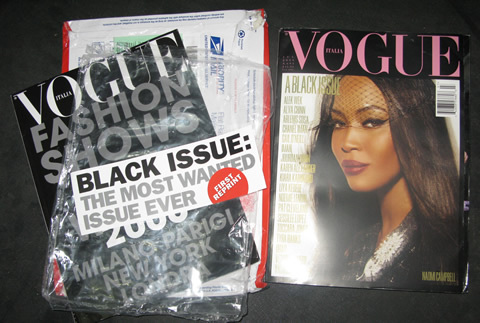| From left (L) to right (R): Liya Kebede, Sessilee Lopez, Jourdan Dunn, Naomi Campbell. |
The July 2008 issue of Vogue Italia initiated an enormous buzz among the fashion elites upon its release. Some people dismissed it as a marketing gimmick, while some applauded the publication's initiative to increase awareness on the racial problem within the fashion industry.
| Toccara Jones. |
What led to the creation of this issue? After all, the runway and ad campaigns have always lacked diversity, but power players such as casting directors and fashion editors constantly chose to do nothing about it.
"London's not a white city, so why are our catwalks so white?"
Spurred by Barack Obama's 2008 presidential campaign, Vogue Italia editor, Franca Sozzani, together with Meisel discussed the possibilty of an all-black issue in February. She was also very much aware of the controversy surrounding the alarmingly under-representation of non-white models during the 07/08 New York Fashion Week. Things weren't looking good in Milan, either. Out of 1,084 looks, black models only walked out on the runway for 14 TIMES.
"I have asked my advertising clients so many times, 'Can we use a black girl?' They say no. It all comes down to money."
-Photographer, Steven Meisel.
Additionally, it's interesting to note that the paid ads in the magazine predominantly featured white models; therefore, indirectly emphasizing the All Black Issue's significance towards the racial issue. Sozzani herself set out to disprove the notion that diversity doesn't sell.
Eventually, it turned out to be one of Vogue Italia's best-selling issues. It also marked a new milestone for the Conde Nast publication where it became the first Vogue Italia to be reprinted due to popular demand. Hence, Sozzani's risk became a powerful statement against a widespread misconception, and most importantly, in perpetuating an open discussion concerning the subtle discrimination in the fashion and advertising business.
The All Black Issue is just one of many examples which affirms the purpose of magazines not only as a news source, but they could even be news itself.

No comments:
Post a Comment